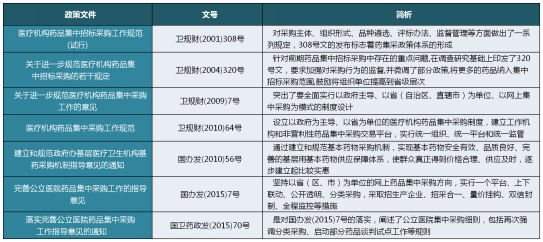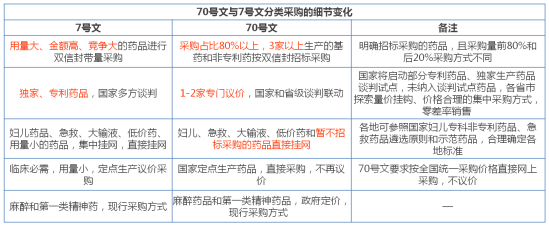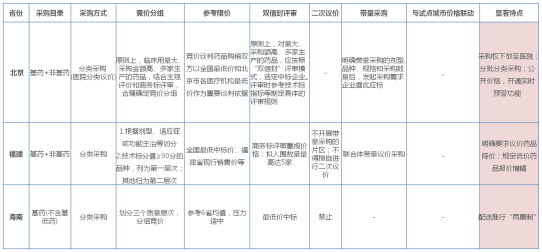1. Bidding environment
1. Development of national drug bidding and procurement
China\'s centralized drug procurement started in the 1990s, and has experienced decentralized procurement by hospitals, relying on for-profit third-party intermediaries to carry out centralized drug procurement at the prefecture-city level, to the establishment of government-led non-profit provincial platform for centralized drug procurement at the provincial (autonomous region and city) level. To the new medical reform since the gradual establishment of basic drug procurement mechanism and other different stages of development.
1) Evolution of national drug bidding and procurement policies
1, 2001 ~ 2005; The implementation period of centralized drug procurement.
Formation of the policy system of centralized drug procurement at the national Level. (No. 308, No. 302)
2, 2009 ~ present Standard period of centralized drug procurement.
Implement the online centralized purchasing method with the province as the unit, and standardize the centralized purchasing of drugs. (No. 7, No. 64), the implementation of the label based drug system. (No. 56) and No. 70 are the implementation of No. 7, reform and improve the centralized procurement of drugs in public hospitals. ([2015] No.7, [2015] No.70)
The policy evolution of national drug bidding and procurement over the years

The background of document 7
Because the current centralized procurement of grass-roots and public hospitals is "one platform, two methods", hospital drug admission and procurement are out of line, some drug prices are high, drug rebates, commercial bribery cases occur frequently and other problems are prominent, reform is imperative.
After 2006, China\'s implementation of centralized drug procurement has played a positive role in standardizing drug procurement behavior, ensuring drug quality and drug safety, reducing false high drug prices, and curbing improper trends in the field of pharmaceutical purchase and sale, especially the implementation of the basic drug system and the construction of a new mechanism for grass-roots drug procurement.
In late February this year, the long-awaited public hospital guidance document was finally issued, which is of great significance to accelerate the reform of public hospitals, standardize the drug circulation order, improve the national drug policy, and establish and improve the drug supply security system based on the basic drug system.
Document 70 issued background
Background: The long-awaited guidance document for public hospitals was finally published on February 28. However, it is the central version, and the bidding plan has not yet been introduced.
2. Introduction: In order to implement document No. 7 issued by the State Office of the People\'s Republic of China (2015), the Health and Family Planning Commission issued Document No. 70 to specifically guide public hospitals to purchase drugs.
Requirements: All localities are required to formulate implementation measures to ensure that a new round of drug collection work is launched within this year.
Content Overview:
Around the "how to purchase, how to distribute, how to settle" and other links, document 70 requires the unified bid opening in mid-to-late November each year, defines the scope of drug procurement, detailed drug classification procurement measures, and adheres to the double-envelope bidding system are the focus of attention.
Second, the impact of the New Deal
The New Deal combs the "troubled times" bidding context:
u The introduction of the New Deal, around what to recruit, how to recruit, how to distribute, how to settle, how to supervise and other key links, put forward targeted innovative measures, provide a policy basis for provincial tenders, and urge the smooth progress of tenders.
u Bidding contradictions are increasingly prominent, the new normal of bidding emerged, the introduction of the New Deal, clear the unified bidding time, the controversial second bargaining has a conclusion, and the classified procurement ideas also escort the effective supply of drugs. .. Various measures sort out this "troubled world" bidding context.
u 2.1 Directory access will be a priority for government affairs
The formulation of the classified procurement catalog will comprehensively consider various factors such as the purchase volume, low-cost drugs, women\'s and children\'s drugs, and various catalogs are even refined to dosage forms and specifications, which determines the complexity and intersectionality of the catalog. It means that drugs with the same generic name may enter different catalogues and tender according to different procurement methods, so the catalogue access work will be the focus of government affairs.

2.2 80% of the drugs will be disqualified from bidding
1. Policy measures
Document No. 70 stipulates that provinces can sort according to the percentage of the purchase amount of various drugs in the total amount of drug procurement in the previous year, and will account for no less than 80% of the total amount of essential drugs and generic drugs produced by three or more enterprises into the scope of bidding procurement.
2. Current situation of drug sales amount
In fact, in the past bidding and procurement in the provinces, the sales distribution of various varieties was pyramid-shaped, and the varieties on the spire were the varieties with huge sales, accounting for the vast majority of sales of all varieties, in line with the 80-20 rule, that is, 20% of the varieties generated 80% of the sales amount.
3. 80% of the drugs were disqualified
About 20% of the varieties meet the proportion of the amount of about 80%, the remaining 80% of the varieties, will be by the four procurement methods other than bidding, but the drugs that can enter the back four procurement methods are less after all, therefore, 80% of the drugs or will not be able to participate in public hospital bidding and procurement.
2.3 The two-envelope model may become stricter
First, questioning "only low price is to take" : In the past, pharmaceutical companies doubted. "Only the low price is to take" is not advisable; It will cause the phenomenon of low drug price, insufficient supply and malicious bid. It is not advisable to propose that "only low price is taken", and comprehensive scoring should be added.
The relevant officials said that the document put forward clear requirements on the double-envelope system, and the first envelope is the comprehensive evaluation of the enterprise, including the evaluation of production, sales, and enterprise scale. The second envelope is entered into the price competition after comprehensive evaluation, and the low bid actually conforms to the law of the market.
2.2.4 Clear attitude of the second bargaining: The second bargaining means that the medical institution negotiates the price again when the winning drug enters the hospital procurement on the basis of the provincial drug bidding results; Second bargaining all over the new normal, Anhui Bengbu price cut 25%, Shaanxi Baoji minimum 20%, etc., all reflect the strict price pressure ideas. But Sun Yangjian, deputy director of the health and Family Planning Commission\'s pharmaceutical affairs department, expressed firm opposition to the second bargaining. How on earth the second bargaining becomes a mystery. Article 70 reveals the second bargaining puzzle, which stipulates that provincial bidding procurement, negotiation procurement and fixed-point procurement do not allow hospitals to negotiate twice, allowing the purchase of products and pilot cities to negotiate twice. Recently, at the symposium on innovative construction of a new mechanism for public hospital drug procurement, the Health and Family Planning Commission once again stated its attitude that it is not allowed to negotiate twice.
2.5 Unified bid opening to avoid multiple rounds of price cuts: Document 70 requires provinces to focus on the opening of bids in the second half of November to achieve the national unified market planning by the Health and Family Planning Commission. From the bidding point of view, previously due to the different bidding time of the provinces, the provinces often refer to the price of the target province, and now, the provinces almost open the bid at the same time, which is a benefit for the pharmaceutical company quotation, and can avoid a wave of quotation.
2.6 Promote the standardization of procurement platform construction, drug prices or collapse.
The change of the bidding platform becomes inevitable: The State Council No. 7 and the National Health and Family Planning Commission No. 70, both mentioned the requirement to accelerate the standardization of the procurement platform construction, within the year to complete the interconnection of all provincial platforms and the national drug supply security comprehensive management information platform, indicating that the future change of the bidding platform is inevitable.
Change Status of bidding platform At present, there have been new bidding platforms in some provinces, such as the "three-stream integration" of the new platform in Zhejiang, the "four open" of the new platform in Beijing, and the docking of the new platform in Shanghai with pharmaceutical e-commerce.
Changing Trend of bidding platform : On the new platform, drug prices are more open and transparent; The new platform also ensures that volume and price are linked; At the same time, it indicates that the next step is to focus on the formulation of drug unified coding.
2.7 The one-vote system is becoming more and more likely: most of the invoicing models in the market are multi-vote systems, with only Fujian and other places implementing two-vote systems. Document No. 7 of the State Development Office [2015] encourages the implementation of the one-vote system, and document No. 70 mentions various ways to create conditions for the promotion of the one-vote system. The one-vote system is becoming more and more likely, a large number of commercial companies are dying, accelerating transformation, and the industrial business system needs to be restructured.
Third, provincial bidding
3.1nbsp; After the introduction of the New Deal, provincial tendering overview: public hospital guidance documents have not been issued as scheduled, the progress of bidding around the country has slowed down, and the expected bidding year has been delayed in the future. Now the guiding documents have been issued, the relevant implementation rules have also come out, coupled with the implementation of the drug price policy, the reform has made substantial progress, and the provincial bidding has officially set sail, and the long-awaited bidding year is being held.
1, Beijing first, the hospital classification of bargaining, procurement authority delegated to the hospital.
2, Sichuan released plans to re-layout classified procurement
3. Fujian abandons inverted double envelopes and restarts bidding.
4, Hainan closely follow the policy, the bidding progress is rapid.
5, Liaoning abolished the basic drug program, and started the same recruitment project of basic drugs and non-basic drugs.
6, Guangxi by drug dosage form classification procurement attention.
After the introduction of document 70, Sichuan re-arranged classified procurement, Fujian restarted bidding, and Liaoning abolished basic drug projects. The three provinces followed the policy and rearranged the bidding, and more provinces will follow suit in the future, such as Jiangxi and Hebei.
3.2nbsp; After the introduction of the New Deal, the bidding rules of the provinces are at a glance


Iv. Bidding trends
4.1 Overview of bidding Trends
After the introduction of the New Deal, the new normal of bidding emerged, and the bidding all over the country was on the right track: classified procurement procurement ideas were established, pilot cities were purchasing by themselves, adhering to the double-envelope system, returning to the business evaluation of the price model, the merger bidding group, the basic drug non-basic drug with the same bid, the second bargaining had a conclusion, clearly the "quantity" of the quantity procurement, and effectively implemented the quantity procurement policy... The new normal of bidding has emerged, and it is highly popular
